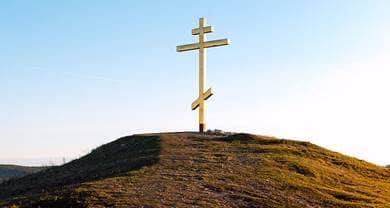- Trending:
- Forgiveness
- |
- Resurrection
- |
- Joy
- |
- Feminism
- |
- Afterlife

RELIGION LIBRARY
Eastern Orthodoxy
Rites and Ceremonies
Eastern Orthodoxy recognizes the same seven sacraments as the Roman Catholic tradition. They are baptism, chrismation (called confirmation in the western rites), Eucharist, confession, ordination, marriage, and the anointing of the sick. As in other Christian traditions, baptism and the Eucharist are the most significant sacraments. This article supplements the general understanding of the sacraments with an introduction to some of the distinctive features of Eastern Orthodox sacramental practice.
The rites of the sacraments are very similar to those in Roman Catholicism, but in Eastern Orthodoxy the physical ingredients of the rites are used generously in full confidence of the divine transformation of the tangible world. Baptism is conducted by full immersion, with liberal amounts of water used. The Eucharist is offered with leavened bread. The priest does not go behind a screen to hear confession, but stands with the person confessing, and lays his hands on the person's head.
It could be said that the goal of Eastern Orthodoxy is to transform all of life into a sacrament. As a result, any number of activities can be made sacred, although these activities, called sacramentals, do not have the same significance as the seven sacraments. Nearly any activity can be sacramental, including the blessing of homes or businesses, the blessing of a voyage, prayers over cars and trains, and the burial of the dead.
The Eucharistic service is called the Divine Liturgy in Eastern Orthodoxy. The Divine Liturgy dates at least to the time of Basil of Caesarea in the 4th century. Basil wrote down a form of the liturgy in use at the time. Eastern Orthodoxy teaches that Basil's liturgy is based on the liturgy created by James the Apostle, first bishop of Jerusalem. Called the Liturgy of St. Basil the Great, Basil's liturgy is used at special times during the year, while the normal Eucharistic service uses the Liturgy of St. John Chrysostom, a slightly shorter version of Basil's liturgy. This use of an ancient liturgy promotes a sense of universality, as every Orthodox Christian in the world prays and worships in the same way. The repetition of a shared liturgy across the centuries reflects the Orthodox Christians' belief in participation in a communion of saints, the community of Christians past and present.
There is nothing spontaneous about the conduct of the liturgy. Every word and act is prescribed in minute detail, and every aspect of the service is symbolic. The symbolism is rooted in the stories of the Bible, particularly the New Testament. For example, the wine used in the Eucharist must be red, because that is the color of blood. It is mixed with water, because the Gospel of John reports that after Jesus had died on the cross, a soldier pierced his side with a spear and blood and water flowed out (John 19:33-35).
The bread used in the Eucharist is baked, arranged, and cut in specific ways to recall such Gospel stories as the miraculous feeding of the five thousand, and the crucifixion. All priests wear distinctive garments called vestments, which also carry symbolic meaning. The priest will say specific prayers as he puts on each piece of clothing; most of these prayers come from the Old Testament and explain its meaning. For example, when the priest puts on a cloth belt called a zone or girdle, he prays, "Blessed is God, who girds me with power and has made my way blameless. He strengthens my feet like hind's feet and sets me on high places" (from Habakkuk 3:19).
The Divine Liturgy proceeds in three parts. The first is called the Proskomedia, a Greek word meaning "offering," during which the priests prepare the bread and wine for the communion. The second is called the Liturgy of the Catechumens. In the early church, catechumens were people preparing for baptism or chrismation. During this part of the Liturgy, everyone is welcome to participate. The priests and the congregation say litanies, or prayers of petition in which the needs of the church, the nation, and the world are recited in unison. The final part of the Liturgy, devoted to the Eucharist, is called the Liturgy of the Faithful. Those not baptized and confirmed in the tradition do not participate in the Eucharist. The Eucharist is followed by prayers of thanksgiving, and a dismissal by the priest.
Most of the Proskomedia happens in the sanctuary behind the iconostasis. While the priests prepare the offering, the congregation participates in further litanies. Every part of the service except the homily is chanted, and normally a choir sings while the congregation does not. Clouds of incense fill the church at specific moments, signifying the prayers of the congregation rising to heaven, and signifying the presence of the Holy Spirit.
Orthodox Christians believe that at the end of the Eucharistic prayer, the bread and wine are literally transformed into the body and blood of Christ. As a result, all of the bread and wine, including the smallest drops and crumbs, are treated with the greatest care. Communicants will often drink additional water to wash any remaining bread and wine from their mouths, and the plates and chalices are carefully washed. While the Orthodox subscribe to a form of the doctrine of transubstantiation, they do not speak of it in logical terms, preferring to emphasize the mystery of the transformation.
The Divine Liturgy is marked by beauty and splendor, evoking a sense of awe and wonder. It is said to occur outside of normal time, in the eternity of heaven. Yet the congregation displays a feeling of informality rarely seen in the more ordered masses of the western liturgical traditions. Orthodox Christians stand throughout the service, but they also walk around, pray and make offerings before icons, bow or prostrate themselves, and make the sign of the cross, as they are moved to do so. People arrive late and leave early. While the services can be very long, they can also finish in less than two hours. Throughout its history, Eastern Orthodoxy has conducted services in the local language.
Study Questions:
1. What are the seven sacraments of the Eastern Orthodox church? How are some performed?
2. How can all of life be transformed into a sacrament?
3. What is Basil’s Divine Liturgy? When is it used?
4. Why is ritual deeply structured?
5. Describe the three parts of the Divine Liturgy.










